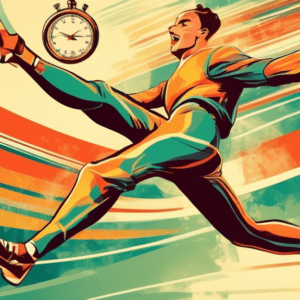Scissor Kicks for Speed Development
Understanding the Mechanics of Speed
Before diving into the specifics of scissor kicks, it’s crucial to understand what constitutes speed and how it’s generated. Speed, in essence, is the ability to move your body or parts of it swiftly from one point to another. It’s a combination of:
Stride Length:
This refers to the distance covered with each stride you take. Longer strides generally translate to faster speeds, assuming an efficient technique.
Stride Frequency:
This refers to the number of strides you take per unit of time. A higher stride frequency means you’re cycling through your strides faster, contributing to overall speed.
Power Output:
This involves the force your muscles generate to propel your body forward. Greater power output translates to more forceful strides and subsequently, greater speed.
Why Scissor Kicks Matter for Speed
Scissor kicks, often overlooked, play a surprisingly significant role in enhancing the elements mentioned above. Here’s how:
1. Improved Hip Flexor Strength:
The upward phase of the scissor kick, where you bring your leg up, directly engages your hip flexors. Strong hip flexors are crucial for a powerful and efficient upward drive of the knee, contributing to both stride length and frequency.
2. Enhanced Hip Extension:
As you drive your leg back down in the scissor kick, you activate your gluteal muscles, responsible for hip extension. Strong hip extension is fundamental for a powerful push-off, directly impacting stride length and overall speed.
3. Core Engagement and Stability:
Maintaining proper form during scissor kicks requires significant core engagement to stabilize your body. This core strength translates to better balance and control during sprinting, enabling you to maintain efficient form even at high speeds.
4. Increased Range of Motion:
The dynamic stretching component of scissor kicks improves the flexibility and range of motion in your hip flexors and hamstrings. This enhanced flexibility contributes to a more fluid and powerful sprinting motion.
Proper Scissor Kick Technique
To reap the maximum benefits of scissor kicks and minimize the risk of injury, proper technique is paramount:
1. Starting Position:
Lie flat on your back with your legs extended straight and your arms by your sides, palms facing down. Engage your core muscles to stabilize your spine.
2. Upward Phase:
Keeping one leg straight and slightly raised above the ground, raise the other leg towards the ceiling in a controlled motion. Aim for a 45-degree angle with your torso for optimal hip flexor engagement.
3. Downward Phase:
Lower your raised leg back down in a controlled manner, simultaneously raising the opposite leg. Maintain tension throughout the movement to engage your muscles effectively.
4. Breathing:
Breathe naturally throughout the exercise, inhaling as you lower your leg and exhaling as you raise it. Avoid holding your breath.
Integrating Scissor Kicks into Your Training Regimen
Scissor kicks are best incorporated into your warm-up or cool-down routine:
Warm-up:
Perform 2-3 sets of 10-15 repetitions per leg to prepare your hip flexors, glutes, and core for more strenuous activity.
Cool-down:
In addition to their performance benefits, scissor kicks can aid in recovery by reducing muscle soreness and promoting blood flow. Incorporate a few sets after your workout for a thorough cool-down.
Variations for Progression
As your strength and flexibility improve, you can challenge yourself further with these variations:
1. Weighted Scissor Kicks:
Holding a light dumbbell or ankle weight on your raised leg adds resistance, increasing the intensity and effectiveness of the exercise.
2. Resistance Band Scissor Kicks:
Loop a resistance band around your ankles, providing constant tension throughout the movement and further challenging your hip flexors and glutes.
3. Stability Ball Scissor Kicks:
Performing scissor kicks with your lower back resting on a stability ball introduces an element of instability, requiring greater core engagement and coordination.
Safety Considerations and Common Mistakes
While generally safe, it’s important to be mindful of these factors when performing scissor kicks:
1. Avoid Arching Your Back:
Maintain a neutral spine throughout the exercise. Arching your back can strain your lower back muscles.
2. Control Your Movements:
Avoid using momentum to swing your legs. Focus on slow, controlled movements to engage the targeted muscles effectively.
3. Listen to Your Body:
If you experience any pain or discomfort, stop the exercise and consult with a healthcare professional.
Conclusion: Scissor Kicks – A Small Movement, Big Impact
While seemingly simple, scissor kicks offer a potent tool for enhancing speed development by strengthening crucial muscle groups, improving flexibility, and promoting core stability. By incorporating this exercise into your training regimen and focusing on proper technique, you can unlock a new level of athletic potential and sprint your way to success.
